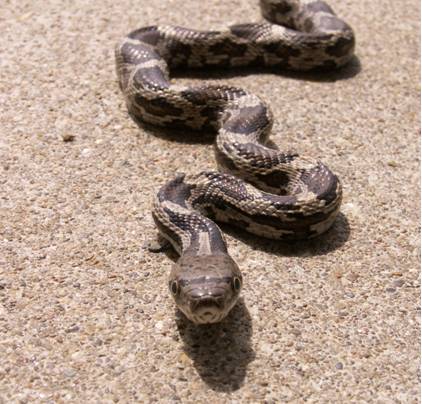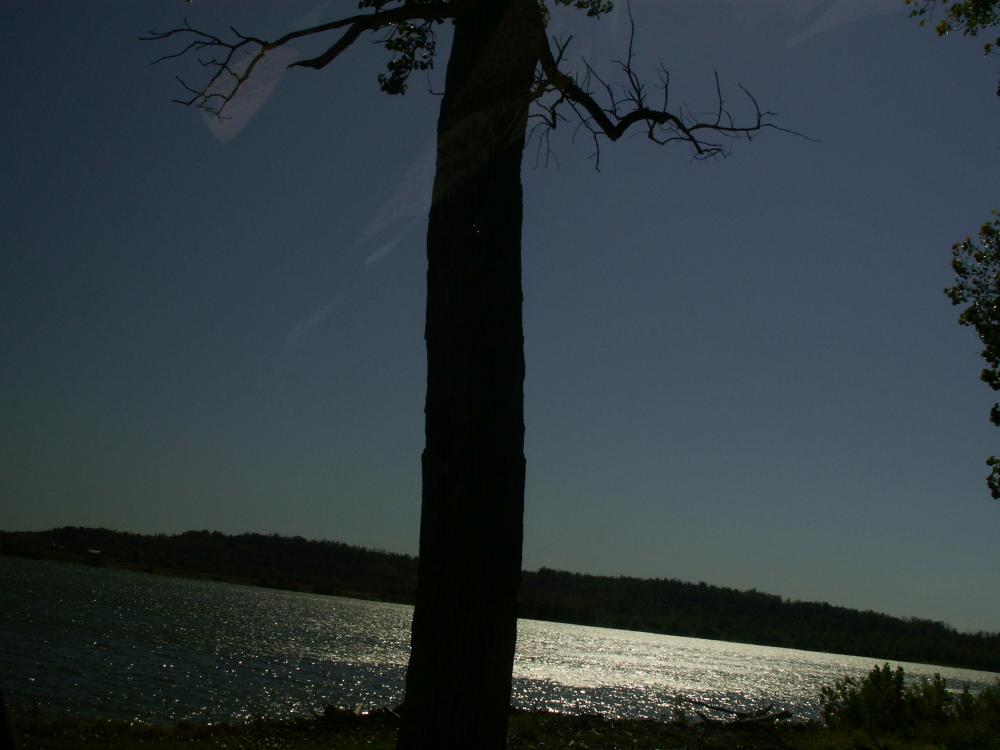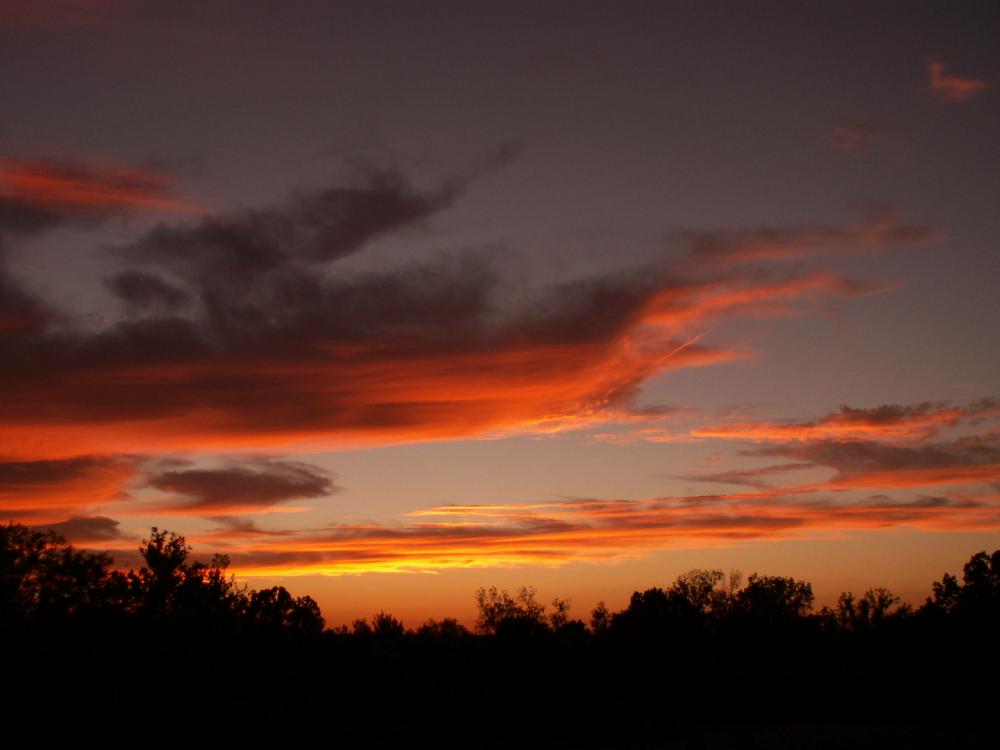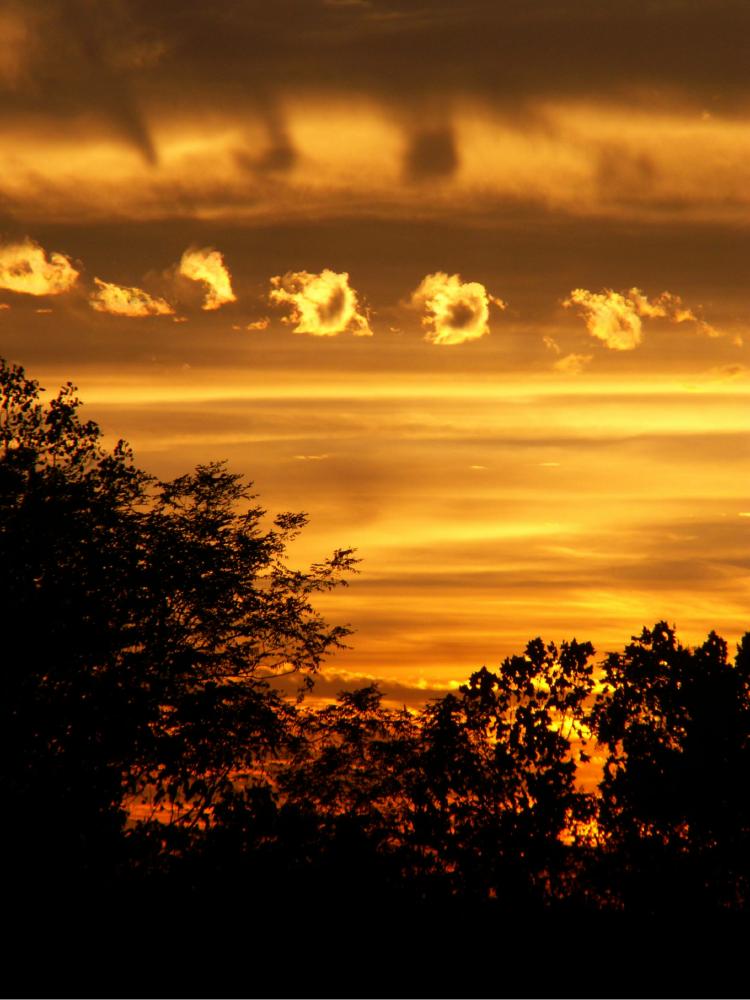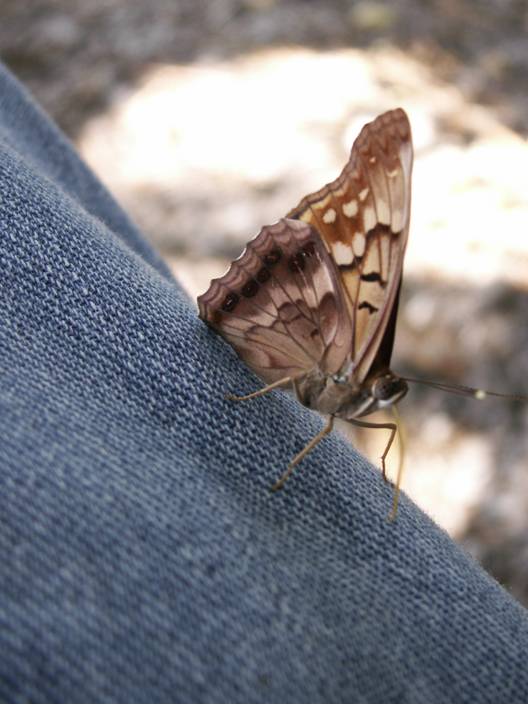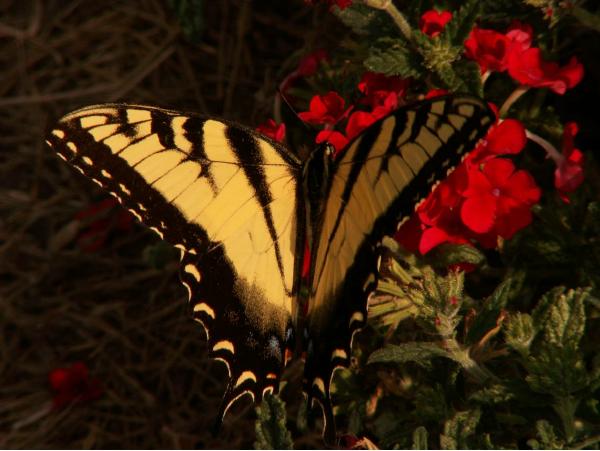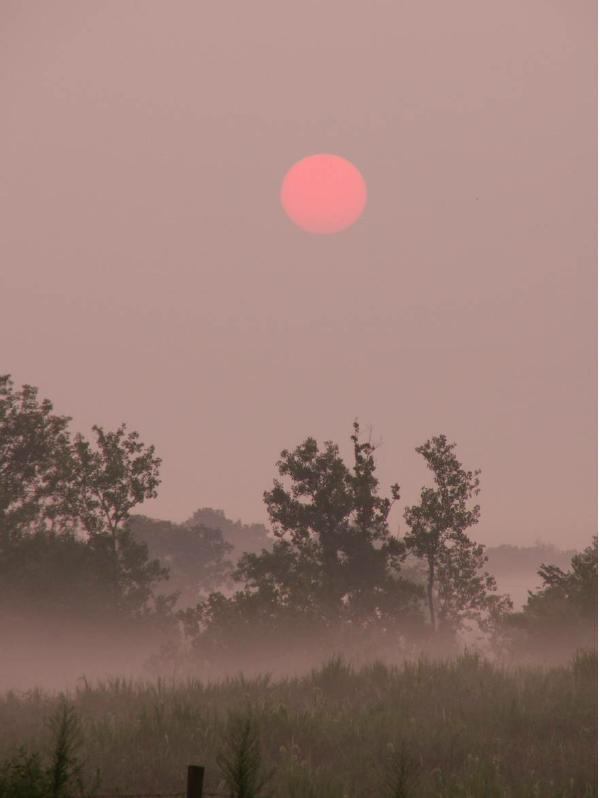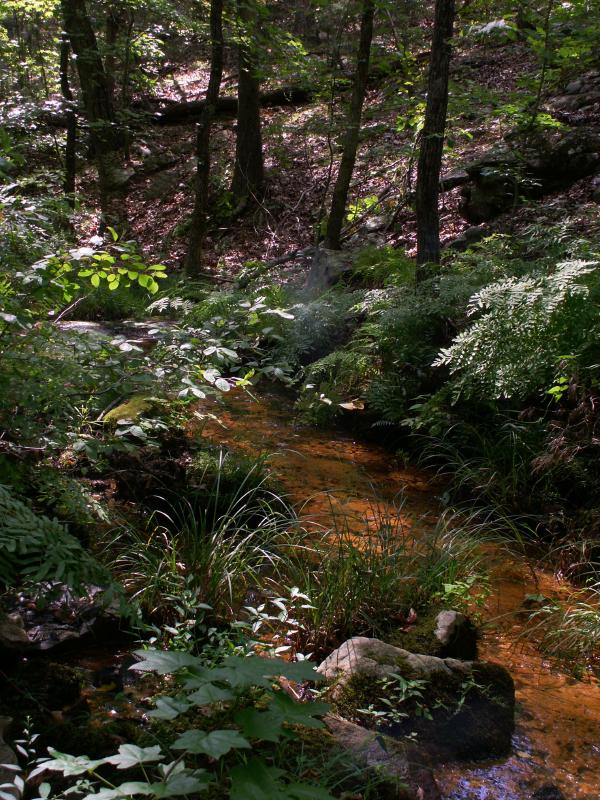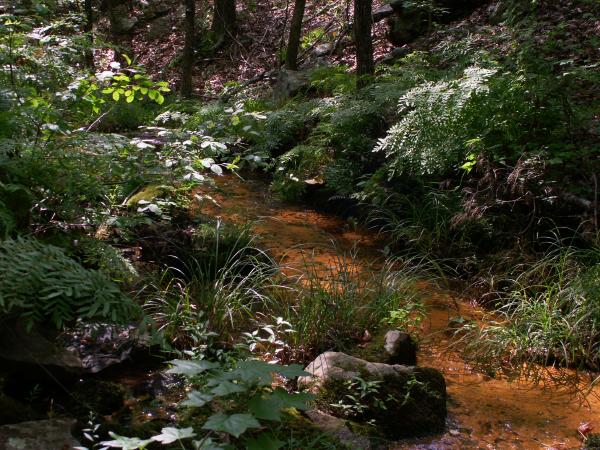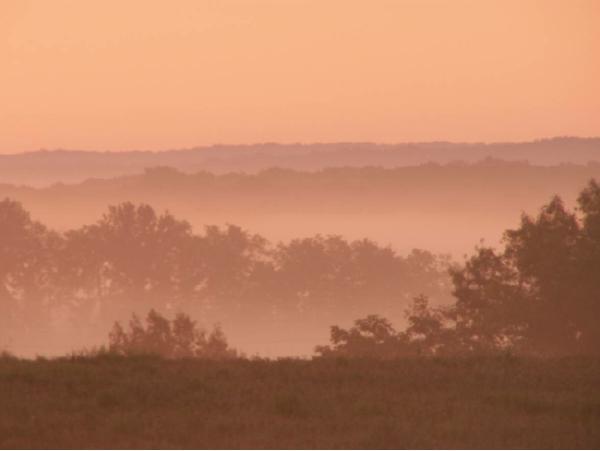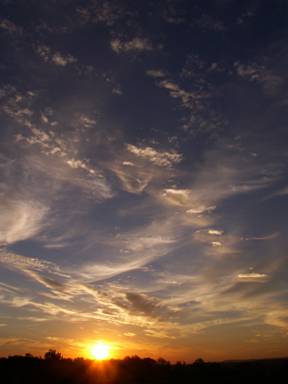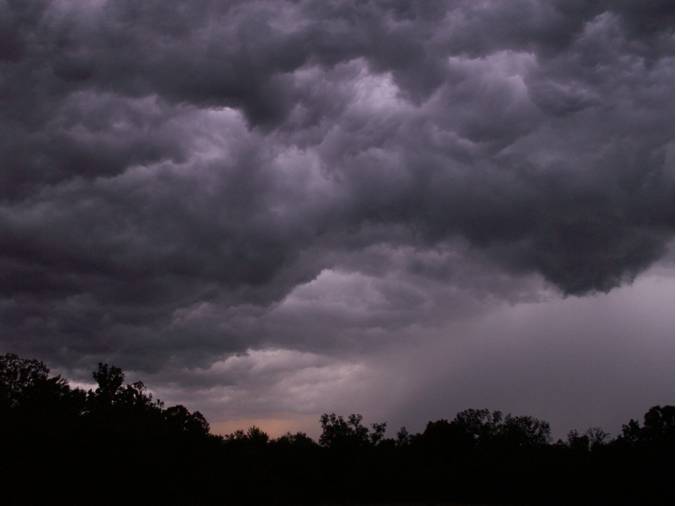|
|
|||||||||||||||||||||||||||||||||||||||||||||||||||||||||||||||||||||||||||||||||||||||||||||||||
|
|
||||||||||||||||||||||||||||||||||||||||||||||||||||||||||||||||||||||||||||||||||||||||||||||||
|
|
The snake and I were both curious about each other. The difference is, I had a camera and the snake didn't.
New friends are where you find them.
Gary DeNeal, April 2011
DIGNITY
Dignity is a quality seen in people, of course, as well as cats and dogs and other creatures. Somehow it is an attribution not often associated with turkey vultures, the scavengers that rule the skies these April days; that swoop, and glide, and in other ways perform their lives away searching for precious carcasses.
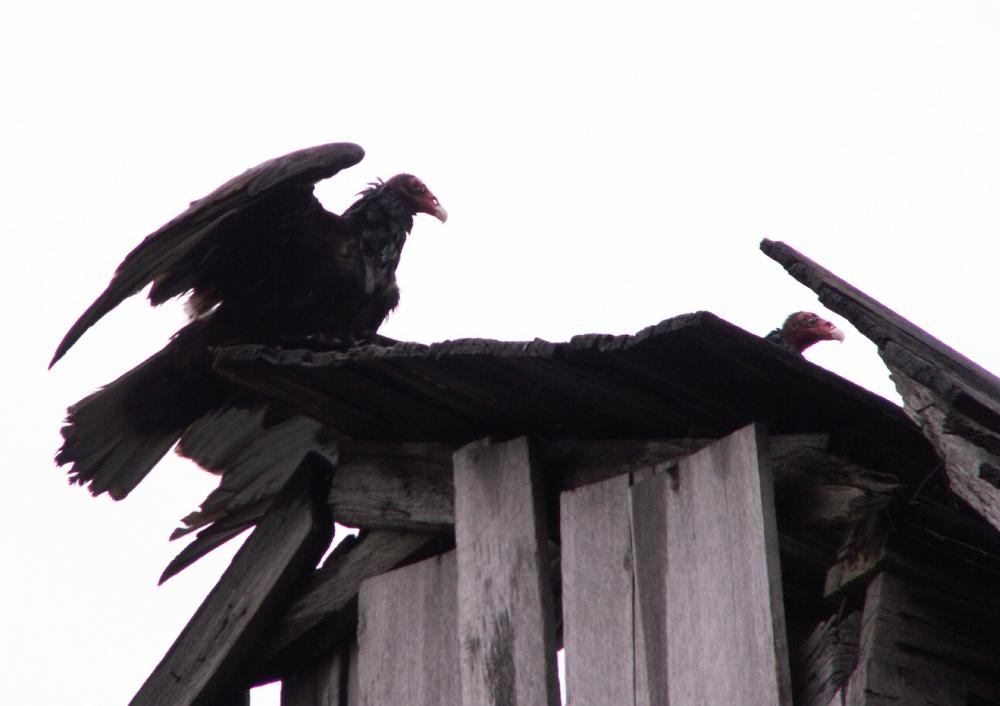 |
Read a poem, if a book is handy, or, study an important painting, or listen to a piece of music good enough to withstand the ravages of time. If none of these is available, however, do something equally inspiring—observe a lowly “buzzard” high in the sky.
These birds can’t fly all the time. Here is one caught in the act of leaving its perch. Moments before, a man with the camera happened upon two turkey vultures that were waiting out a rainstorm from atop a barn that had seen better days. One shot was allowed, this one.
Gary DeNeal, April, 2011
DARK EARTH, BRIGHT WATER: ROSICLARE, ILLINOIS
On a darkening day in late October, the river’s sheen remains.
Across the Ohio, Kentucky is as dark as Illinois.
|
|
Both are as dark as the river is bright.
Soon it will be winter. Soon high-flying geese in ragged vees will fill the nights and days with their cries. Not yet, however. For now, it is only dark earth, bright river, and a tree.
That’s enough for now.
Gary DeNeal, October, 2010
THE COLORS OF CAVE-IN-ROCK
To read The Outlaws of Cave-in-Rock, Satan’s Ferryman, and Spawn of Evil is to conclude the dominant color of Cave-in-Rock, Illinois, is red. Blood red! In fact, Paul I. Wellman in Spawn of Evil credits the cave as having been the birthplace of organized crime in the United States.
|
|
Today, the color red marks the locale once the sun sinks low, but other colors compliment the one most associated with organized mayhem back in the 1790s.
When the light is right, 2010 has the look and feel of 1795.
Gaze upon the sunset and dream.
Be thankful the outlaws are nowhere to be seen.
Gary DeNeal, October, 2010
ON LOOKING CLOSE AND
LOOKING FAR
|
|
By looking into the Passion Flower, the photographer sees an otherworldly carnival begging to be captured for posterity before the frost hits. Snap, snap, snap, then more snapping, resulting in several photographs that are blurry enough to be both enchanting and unusable here. This is one flower where one can get lost. Call it abyss of bloom! As protection from total sensory overload, the photographer turns his camera to the dying day and by doing so is bombarded with sensory overload times two. Better yet call it enchantment, bedazzlement, enhancement, color-induced madness…The possibilities are endless. As the final protection, the poor guy clicks the lid over the camera lens. Another day worthy of being marked off the calendar except by this time the man is so addled he can’t find the calendar.
Sense serves to balance sensory overload—sometimes.
|
|
|
|
Gary DeNeal, September, 2010
CAVE-IN-ROCK, LATE AUGUST
It’s just limestone and sweet gum, river and sky; in other words, Cave-in-Rock, late August. Look hard and you may see 2010 peeking around the edges, but you have to look hard. Otherwise, this could be 1810, or 1610, or, for that matter, 1010.
|
|
This is one of several snapshots made on an afternoon late in summer.
The driftwood upstream drifts downstream, past limestone and sweet gum, under a sky not nearly as wide than one’s imagination.
August, 2010

FULL MOON, LATE AUGUST
Dust in the air following the corn harvest may have been why the rising moon was pink last night; but when I snapped this photograph it seemed more the color of a dusty rose. Soon after that, the moon was high, seemingly smaller than before, the silver orb of story and song. Dogs barked.
August, 2010
A NEW FRIEND
|
|
These days I can say without lying, “Some of my closest friends are butterflies.” The little fellow shown here is often found on my elbow or wrist. This morning it chose to be slightly less personal and landed on my pants.
No problem. Unlike spiders, wasps, or
mosquitoes, butterflies carry no threat of any kind. Unlike
certain pea-green parrots they do not scream into one’s ear
with enough piercing velocity to render thinking impossible.
Butterflies just luxuriate in their own multicolored brilliance.
They are reminders in miniature that the everyday opens windows
onto wonders.
Stare at a leaf as it brightens into yellow and red and see autumn in its entirety. Stare at the butterfly's wing and be steeped in magic and mystery.
Let’s say I’m trying to write a poem and the meter is wrong and the words are off kilter, well, so long as that butterfly perches on my elbow, it doesn’t really matter if the words on paper don’t make it, a poem is “happening” anyway.
Please stay, butterfly, for as long as you can—your beauty is unmatched, your manners are impeccable. Besides, we all know true friends are hard to come by these days.
August, 2010
BUNNY FAR FROM ORDINARY
|
|
Fear
me, bunny, and while you’re at it quit eating our flowers. I
am man, otherwise known as Fierceness Personified, and
you are just a lowly beast. Less than grown, you are, and for
danger not to be part of your mindset is a grave oversight on
someone’s part. You are supposed to flee immediately when in
the presence of a larger beast, i.e. me. In case you haven’t
heard, this is not
August, 2010
|
|
The best time of day to “capture” a Tiger Swallowtail is early in the morning when its wings are damp with dew from the night before. Into the heat of the day, the tireless critter has little time to waste posing for a mere idler with a camera. There are too many blossoms to be visited, too much nectar to be extracted. For any butterfly there is just too little time, period. Most of my attempts to photograph the colorful visitor show wings blurred against a backdrop of in-focus flowers. Occasionally, however, these wings are still long enough for a proper shot.
Feast your eyes on a lonely feast. Royalty prefers to dine alone.
August, 2010
VISITOR AT SUNRISE
|
|
It is early morning and I am looking east. Fog was here before August had a name and is here again this morning. Shown, as well, is the sun, our very own medallion that into the morning will become a perfect furnace, baking cornfields, and bluff tops, and any of us foolish enough to avoid the shade.
Medallion or furnace, or merely a perfect circle roaring with flames too intense for viewing straight on, the sun is here to be taken for granted, to warm our toes and create our shadows.
Welcome, sun, to what has always been yours and where we are only visitors.
August, 2010
OFF THE BEATEN PATH BY
SEVERAL CENTURIES
|
|
Ferns surround the creek. In the depths of the forest, in a place either unnamed or name unknown to Springhouse, the water trickles with the color of rust, this due to an abundance of iron oxide. No automobile can be heard in the distance. Only distance is heard in the distance; that, and the songs of birds and insects. Here, too, is southern Illinois in deep Summer. Invested with beauty, infested with ticks, the terrain we hold to be nameless may be the same today as it was hundreds, if not thousands, of years ago.
We can always pretend.
Gary DeNeal, August 2010
|
|
SURVIVOR
Outstanding at Standing Out
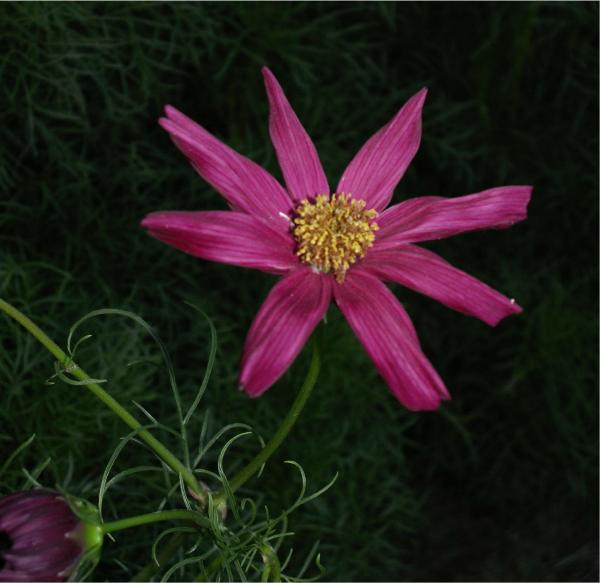 |
This parched day in late July, a single blossom proves local color will be on display no matter what.
Gary DeNeal, July, 2010
MORNING FOG
|
|
What you see is the fog against the hills. It is the dawn of a day threatening to be one of the hottest of the year. What you do not see are the swallows dipping and diving, or the doves flying in, cooing as they arrive.
You do not hear the dog barking to the east.
This much is known: this foggy dawn in mid-July is as cool as this day is going to get. Savor it the mind says, yet the savoring proves slightly less brief than the click of the camera.
The fog will soon be gone to memory.
A moment soon to be burned away by the sun is what you see.
Gary DeNeal, July 2010
SPRITE IN THE HEAVENS, DANCER IN THE SUN
|
|
To see them requires looking upward, and then only on the rarest occasions. The sprite was seen prior to a storm, the dancer just after sunrise. A moment later these rarest of visitors were gone, leaving the viewer to a day weighed down by necessary tasks that now seemed a tad less necessary, thanks to having looked up and seeing, if only for a moment, the sprite and the dancer.
|
|
Gary DeNeal, July, 2010
A NEW
DAY. SO WHAT?
|
|
The
greeting from the East serves double duty by reminding us the standard
has been set for the day. Onward! The morning sky has shown the way. Gary DeNeal, July 2010 |
Garden of the Gods - Summer 2010
Click on Image for a Larger View
Gary DeNeal, June, 2010
Visitors
|
|
That’s how it was late yesterday afternoon. Overhead there appeared visitors from a torn-paper other dimension, a place full of drama beyond the obligatory lightning and thunder. Our dog failed to appreciate the charm of it all, yet he stayed nearby as I took too many photographs to count. He is that kind of dog.
For a few minutes, I had the impression any design was possible, that despite textbooks going back centuries, everything was essentially NEW.
Gary DeNeal, June 2010
Never Again
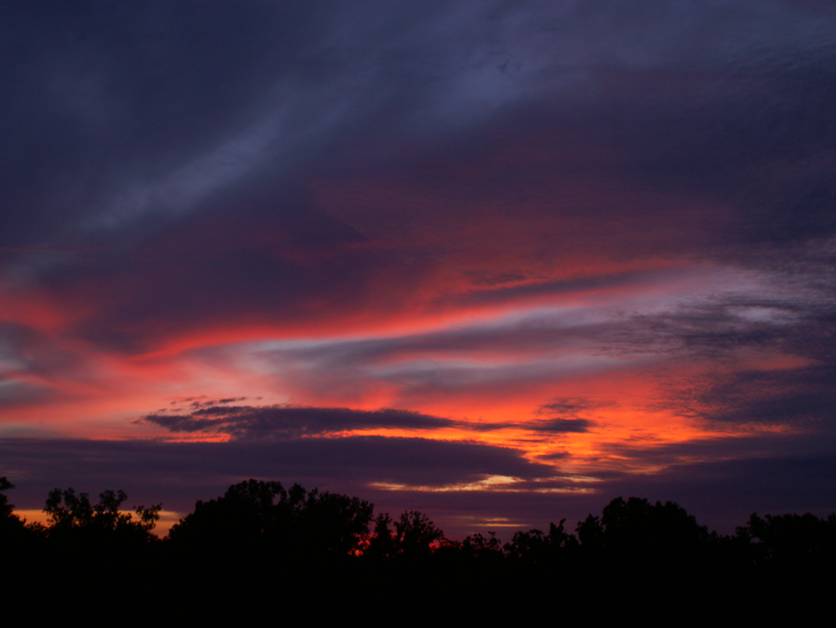 |
Look quick, amateur photographer, for with each passing moment subtle changes occur. (A time or two the sunset-watching dog and I have been dive-bombed by angry barn swallows, but that's for another time.)
Click away, click away, this moment, this NOW will never happen again.
Never.
Gary DeNeal, June 2010
Watching
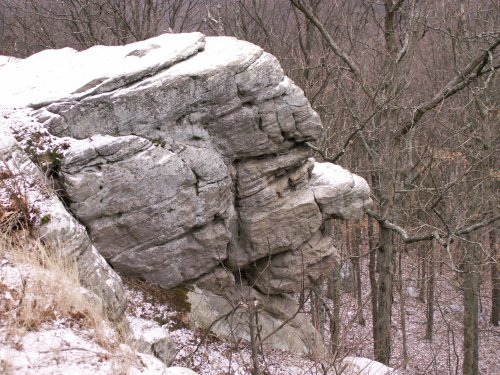 |
Not so long ago, Old Stone Face was picnicked so frequently one would have thought the old girl might have broken into a frown. She didn’t. These days, Saline County’s once-symbol stares into the western distance and is mostly ignored. Being mostly ignored is what Old Stone Face does best. The Indians paid her little mind, and neither did the settlers under the weight of their rifles and axes. The last glacier managed to inch its grimy vastness almost to bluff’s edge never dreaming it was being observed by a face wind had taken its time sculpting from sandstone. |
|
We enter, we exit; the Old Stone Face stays right where it is. Victim of moods and circumstance, we exhibit body language at first opportunity. We dance, we weep, we write speeches and rob banks and rescue people from burning buildings, but Old Stone Face just stares into the western distance. For her watchfulness is everything. From time to time it is good, I think, to turn our minds to this all but forgotten rock formation that may resemble us but is otherwise not like us at all. Gary DeNeal, March 2008 |
|
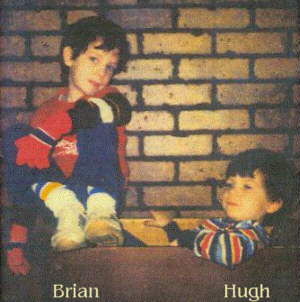
THE WOODBOX
GANG:
THE STORY BEHIND THE NAME
This
simple but sturdy box my father had sawed from boards bought at
the nearby lumberyard. Made of wood and made to hold firewood,
it was a woodbox all the way.
One day I noticed my sons lounging in
this roughhewn monument to utility set next to the woodstove,
and knowing a promising snapshot had just tapped my shoulder, I
grabbed the camera, saying, “You guys must be the Woodbox
Gang.” The name came without effort probably because I had
been reading up on Butch Cassidy, the Sundance Kid, and their
Hole-in-the Wall Gang of occasionally genial outlaws. The
phraseology must have worked because Brian and Hugh remembered
that name.
After the decision was made to travel extensively—extensively meaning from coast to coast, and back again with side trips to just this side of Canada—Brian dropped out. There was no way he could be a newspaper reporter and a traveling musician at the same time. Hugh stayed and is now one of five musicians who travel the country as the Woodbox Gang. These days, t-shirts emblazoned with the band’s name turn up in unlikely places; don’t be surprised if one shows up on a street near you. To date, this mostly merry, but occasionally brooding band of five has done seven CDs and is working on an eighth. Stay tuned.
From New York City to San Francisco, the words Woodbox Gang evoke an image of frenetic picking and singing, raucous lyrics, and a wild good time by fans who take delight in stomping their feet to melodies that have southern Illinois’ “make-do-with-what-you-got” written all over them. To me, on the periphery where fathers are supposed to be, these two words, Woodbox Gang, bring to mind two brothers enjoying their grandpa’s handiwork.
Gary DeNeal, September 2007

In high school, we were taught to memorize lines from Shakespeare, Keats, and even Robert W. Service. Kids don’t do that so much these days, or so I am told. However, as the 1950s prepared to fade into history, such activity was necessary for getting passing grades in English at Harrisburg Township High School. I found the task distasteful but did my best.
Now, fifty years later, I am still trying to memorize important works. In no particular order, these are the poems: “Elegy Written in a Country Churchyard” by Thomas Gray, “Ode to a Nightingale” and “The Eve of St. Agnes” both by John Keats, and “The Hound of Heaven” by Francis Thompson.
1. Everybody knows the aging brain needs extra activity. Some prefer crossword puzzles. I chose attempting to “absorb” poems considered classics of their kind. It is hoped that remark doesn’t sound too elitist.
2. Wherever one looks these days, it appears young people have cell phones stuck to their ears. Apparently it is of vital importance for the young to communicate with each other via cell phones these days and to do so as often as possible; yet this old-timer cannot help but wonder what urgent messages are flying back and forth? Hopelessly out of date, I chose to leave fashionable chatter to others and devote what mental energy remains to absorbing words that have proven their worth. Nature instructs each of us to fill our personal vacuums in various ways, I suppose. Now THAT really does sound elitist. Sorry.
3. The seed—that is, the desire to memorize certain poems—was planted by an elderly spinster who had taught at Harrisburg High School since the 1920s. Miss Bernice Patterson was the teacher’s name. One is tempted to toss caution to the wind and say Miss Patterson bewitched this former student to such a degree years after her death her influence looms greater than ever. On second thought, the word “bewitched” is not too strong. Only those who remember Miss Patterson will fully grasp that statement.
There you have it, three rather lame reasons why one in his mid-sixties struggles to “absorb” a handful of long poems most people find to be of little worth in their everyday lives. Here is another, perhaps the most compelling of all. To “bow” to the word mastery of great poets by attempting, and failing, to commit to memory their best poems is just one man’s attempt to embrace humility, especially while struggling to write poems of his own.( Doing all this on what may be the hottest day of the year should also win him the Sackcloth and Ashes Award.)
If you must know, Gray’s Elegy Written in a Country Churchyard” has now jumped to the top of the list. That happened because recently in an otherwise delightful book about Abraham Lincoln, the author saw fit to refer to one of Abe’s favorite poems—Gray’s “Elegy” as “morbid.” Such an accusation I considered unfair, uncalled for and downright uncivilized, but it did prompt me to give this masterpiece special attention. Either contrarianism has gotten out of hand here in the Shawnee Hills, or the call of rampaging morbidity is one siren song too strong for yours truly to shun.
Coming in at a strong Number Two is Thompson’s “The Hound of Heaven,” an epic anything but morbid, but alas, it has the least literary status of my four far-from-easy pieces. In fact, of the chosen ones, the poor old Hound has come in for some hearty kicks. Two friends of a literary bent not so long ago chided me for publishing this poem, along with commentary, in Springhouse some issues ago. Whether it was Francis Thompson’s Victorian phrasing or the poet’s deep religious conviction, or both, that caused the problem I’m not certain. Well, that last statement is not exactly true either—the culprit in their eyes was almost certainly the religious content. As Thompson so eloquently states it, God is a hound that is ever searching for us even though we may spend our lives trying to evade him. Being a good Hound, indeed the greatest Hound that ever was, is, or ever will be, he never gives up until he finds his “prey” and slavers said prey with UNCONDITIONAL LOVE!
This much I know for sure: Any poem that gets such a strong negative response has to be worth extra hard study. I’ve been studying it for years, knowing status-wise it was hovering barely above the literary basement. Then, the other day, a book of James Dickey’s poetry criticism showed up and, unpack the bunting and sound the clarion, the author of Deliverance gives it high marks as one of the great religious poems of all time. Surely, somewhere THE HOUND is smiling a smile as all-encompassing as it is toothy.
Almost anyone reading these words can probably commit poems to memory far better than I can. I’m terrible at it. Yet being a born loser in this department is also the impetus to keep trying harder (When seeking an opponent worthy of hard fought battle, always check mirror first.). Maybe at eighty, if I’m lucky enough to reach that age with mind intact, I’ll look back on this near lifelong memorization of poetry as having been a gigantic waste of time. Right now, though, it seems worthwhile and I recommend it to anyone, especially to those youngsters with shiny cell phones glued to their ears.
Gary DeNeal, August 2007
Important Medical Alert: Peanut Butter Can Be Addictive, But So What?
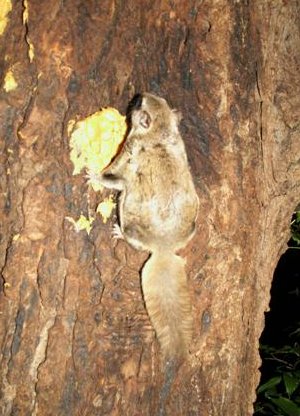
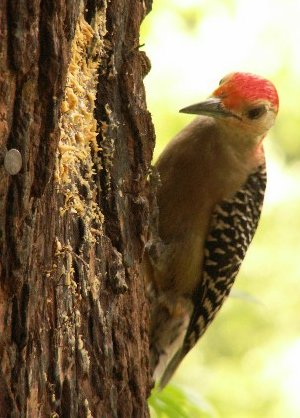
This winter past, I decided to do a good deed by smearing a few spoonfuls of peanut butter on the walnut tree that stands just south of the back porch. This was no big deal, not really, just a matter of opening a jar and applying the aromatic contents within onto the rough tree bark. The birds would have something to look forward to, and all would be well. As it turned out, it wasn’t that simple.
Well, all was well—for about 15 minutes. Soon the squirrels skittered down the tree to sample the offering, and in a day or so, three raccoons showed up for the feast. Neither of these two species is high on table manners. The poor downy woodpecker, the reason for the tree smearing in the first place, was plain out of luck, except for those dabs and dribs of the precious stuff the larger critters had left behind. Still, it was wintertime, a bleak, mean-spirited season, and the squirrels and raccoons were hungry as well as the birds. Each day I kept applying the peanut butter to the tree thinking everything would all work out in the end.
Empty peanut butter jars greeted spring.
Oddly enough, the arrival of warm weather did not diminish the appetites of our little neighbors in the least. What had begun as a lark was now an obligation, a mostly happy obligation, to be sure, but certainly no lark. Any day I missed decorating the tree caused royal chagrin among the regular diners and conscience pangs for the one self-appointed to do the decorating.
Now it is mid-August. Catfish are jumping in farm ponds like crazy and somewhere the cotton is as high as the reading on the thermometer, which this afternoon tops out at 100 in the shade. Cold or hot though, the regular squirrels, the flying squirrels, the raccoons and all the birds are always hungry, never mind that I smear the trees several times daily. That’s right, trees. These torrid days the nearby walnut is only one of four trees receiving the compassion packed in a jar. If I were a millionaire, I’d probably peanut butter the entire forest. That’s called addiction or (OCD) Obsessive Compulsive Disorder, for those of you not up on the latest medical terminology.
So, if coffee is your own worst addiction at present and you wish to balance it with another, turn to peanut butter. The rewards for doing so are legion; the pitfalls are few, if you don’t mind a little old-fashioned poverty now and then.
Let me tidy up this essay by offering a few observations in closing.
If you find yourself essentially friendless, peanut butter applied to the rough bark of nearby trees will gain you friends galore.
You will sleep well at night knowing your efforts have brought momentary happiness to creatures far too familiar with vermin of every variety and forever subject to being preyed upon by other creatures. Let us break this age-old dog eat dog cycle once and for all!
Yes, it is an addiction and with any luck even a first-timer will be hooked for life, as I am; however, in the addiction department medical research has proved beyond a reasonable doubt peanut butter applied forcefully and on a daily basis to tree bark is far healthier than gambling, cigarettes and booze.
By spreading peanut butter on trees, one is also spreading happiness for those not fortunate enough to be able to go to the store and purchase such delicious ambrosia for themselves. Furthermore, once caught in the throes of this particular mania one has less money for the aforementioned and truly destructive addictions of gambling, cigarettes and booze.
Let us strive to bridge the gap between the so-called lower animals and ourselves. Next time you go to a grocery store buy the biggest, brightest jar of crunchy peanut butter on the shelf, and then go home and spread some happiness.
By doing so, you will change lives, not the least of all, your own.
Go ahead, take that leap; become ridiculously compassionate toward creatures many dismiss as mere varmints. Become a hopeless, full-blown, unapologetic peanut butter addict today.
Gary DeNeal
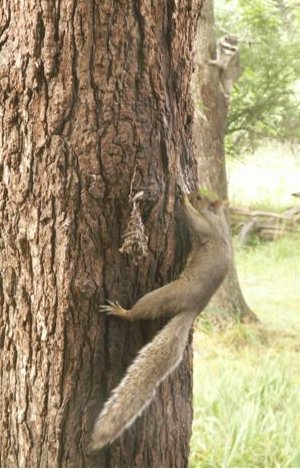
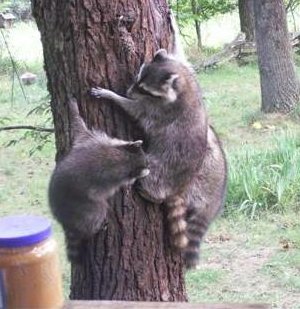
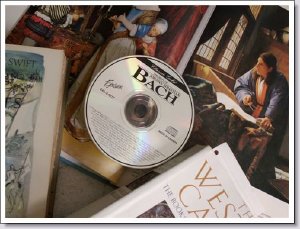
Make of it what you will...
Imagine, two old guys who look like refugees from Lil' Abner turning the dial to NPR of a morning to hear Bach, Beethoven, Mozart, or whoever the DJ chooses to play that day! Shouldn't we be listening to the country station, being from the hills and all? After all, we do live in the hills south of Harrisburg and we do pull our pants on one leg at a time just like men have done since the Dark Ages. Drawl and twang ought to be racing through our blood like that of Flatt and Scruggs masterpiece, Foggy Mountain Breakdown, out of the movie Bonnie and Clyde starring Warren Beatty and Faye Dunaway, but uppity refrains of Ludwig Von and his fellow composers keep pouring forth from our radios anyway defying all known rules of geographical propriety. I reckon Bill and I ought to be examined soon as possible.
Speaking of Harrisburg, I once heard a bookstore owner say good literature sells amazingly well here. Harrisburg is usually noted for its Wal-mart in the swamp part, plus the loveliest jail imaginable on the town square. I found the store owner's bafflement believable for I can name any number of people in and around this once-thriving coal mining town who can talk good books all day long and never once get bored.
Something just doesn't compute and that's just great. Make of this observation what you will.
Gary DeNeal
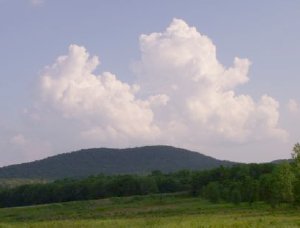
Clouds over Cave Hill - Summer 2007
SUMMER 2007
Call this the summer of clouds
and chiggers. Look up any afternoon and see masterpieces of a
cumulus persuasion lording the horizon. Stately as these giants
are, they cannot diminish the itching brought on by chigger
bites. You might say it's grandeur beyond words and "back
to square one" at the same time.
Listen to the cardinal and be lifted
into cheerfulness, but close your ears to the song of the dove
unless you are one of those rarities who delight in melancholia.
The cardinal is as bright as the song it sings, while the dove
is a gray bird--and a singer powerful enough to make a grown man
weep. These birds share our yard, and keep us grounded in the
reality of yin and yang.
Listen, look up, for summer is upon us
full throttle. Bask in the northern tropics--southern Illinois
style. Drain each day to the dregs, so to speak, but while doing
these things never forget to use the itch cream.
Gary DeNeal, Summer 2007
Send comments on the content of this page to editor@springhousemagazine.com





